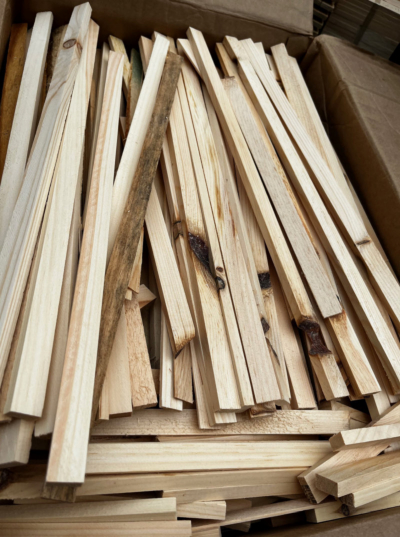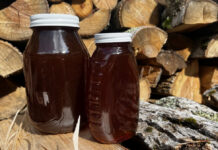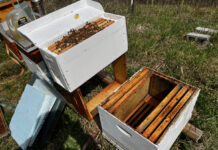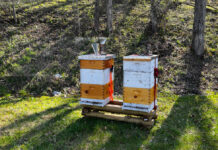I now have eight beehives. The additional hive wasn’t planned, but one of the existing hives was just bursting with so many bees and so much capped brood that I moved two frames of brood (one capped, one with eggs and larvae) plus a frame of resources out of the hive and into a new box. I later added another frame from a different hive, making it a four-frame nuc.
By taking frames from a large active hive and replacing it with empty comb, I gave the queen more room and reduced the chance that the hive will swarm. This is prime swarm season, so I am checking the beehives every week and taking appropriate steps to prevent swarming.
I set the new hive on two cinderblocks for now, but I need to build a new hive stand. There is only one remaining deep hive box unused now. I have two more deeps and three medium supers constructed but not yet painted. Painting will happen after we have enough rain-free days to do the mowing and weed whacking. Painting is next on the list.
Eight beehives are more than I have ever had before, but I try to keep extra equipment on hand for just such a circumstance. By being prepared, I could put the split into a full 10-frame deep box instead of a 5-frame nuc.
The New Queen
As you may recall, I dropped a new queen into a beehive that had lost their queen for an unknown reason. I checked and saw new eggs and young larvae, so she is at home in the new hive and laying. So far, this is a success story. We’ll see how she is doing in another week or two. If all goes well, this hive will be reinvigorated and produce lots of honey.
Prior Splits
I checked both my prior splits and added a second deep box to one of them, checkerboarding two frames up into the top box to pull the bees upward. That split is coming along well. The second split has a queen, and she is laying, but not as much as she should be. While the first split has six frames of brood, this one had only two-and-a-half. I saw a couple of supersedure cells, one of which was charged, meaning it ha da larvae in it. It seems like the bees are planning to replace this weak queen, and I can’t say blame them. She probably didn’t mate well because of the cold weather or rain in April, so the hive is going to try again with a new queen. It will be interesting to see what happens. I won’t know for at least three weeks.
The great thing about bees is that while you can buy a new queen when you need one, you don’t have to because the hive will often raise one of its own. People think the queen is the “boss” of the hive, but that is not the case. The workers get to decide if she remains queen or not.
Expanding into an Out Yard
After asking around, I ran into an individual willing to let me put beehives on his property. (Any apiary or beeyard outside of your home yard is called an “out yard,” short for outlying yard.) Best of all, he lives on the way to town, so every time I leave my house, I pass his. This will make checking on the beehives easy. It is also a lower altitude, so they will get an earlier and possibly longer honey flow.
Moving bees elsewhere will also make my wife happy because she is not in favor of more beehives at the homestead because of limited space. I have hive stands for six hives and we have eight, so I will move at least two hives to this new location. Bees also harass my wife when she gardens, so she puts on a veil, but that is not an ideal solution. With fewer bees on the property, we can hope they leave her in peace.
It’s not a done deal. We’ve discussed it, but I have yet to see the property to learn where he thinks I should put them and if I can access the spot via truck. I’ll also have to put up another electric fence.
Making an Equipment Run
I visited our “local” bee supply store (It’s two hours away) and picked up enough woodenware to assemble four more deep boxes and eight more medium supers. I also picked up enough parts to assemble 100 more medium frames. When assembled and painted, that will give me enough for two more full hives. Hopefully, I won’t need to use the deeps until next year, but it is better to have them and not need them than to need them and not have them. Beekeeping requires its very own preps, and I learned several years ago to have extra equipment on hand.

One reason I like this store is that they give away wood that is trimmed off or rejected from their beehive and frame building. We filled three boxes of kiln-dried kindling to use this coming winter. This stuff doesn’t even need tinder; it is so dry it will burn if you hold a match to it.
To give the bees sufficient food supplies to make it through the winter, I operate with two deep hive bodies and I use medium supers for the honey we harvest from the hives. I plan to have at least three supers on hand for each hive, although smaller hives don’t need that many. When I make new supers, which I do every year because the bee yard is growing, I mix three frames of foundation in with six frames of drawn comb, if possible. Drawn comb allows the bees to spend their energy making honey instead of making wax. By harvest, the foundations are usually drawn out, giving me extra drawn comb for the following year.
I also picked up three dozen quart jars because I have two repeat customers who want quarts of honey and I ran out this winter. (I sell them for $40 each.) Thirty-six quarts is more than 105 pounds of honey.
Honey Production
We’ve had so much rain in the past week that the bees have not made much new honey. I saw petals from a black locust knocked to the ground on our road, so the rain may be limiting how much nectar is available. The blackberries are just beginning to bloom, so I remain hopeful they will provide a much-needed bump in honey production. Blackberries are not the bee’s favorite source of nectar, but they will visit the blossoms when there is nothing better available.
Of the five hives that overwintered and should produce honey this year, one is going full bore and has three supers on it. Another has two supers. The remaining three have one super, and they are not anywhere near full. We need a week or two of sunshine to keep the spring honey season from being a washout.
We are expecting sun Monday through Wednesday, so I will check the hives again Wednesday to see if any need new supers.
It is unlikely the new splits will produce much honey for harvest this year, especially the one I just made and the one that is trying to replace their queen. My goal is for them to fill two large deeps with enough stores to successfully over-winter. That way, they can come out of the winter with young queens and a full head of steam, producing a couple a split and lots of honey in 2025.
Selling Nucs
While I sell plenty of honey, I have never sold nucs. With any luck, I will do so next year. Nucs sell for $200 each, so selling a few nucs would be a nice addition to my farm income.







